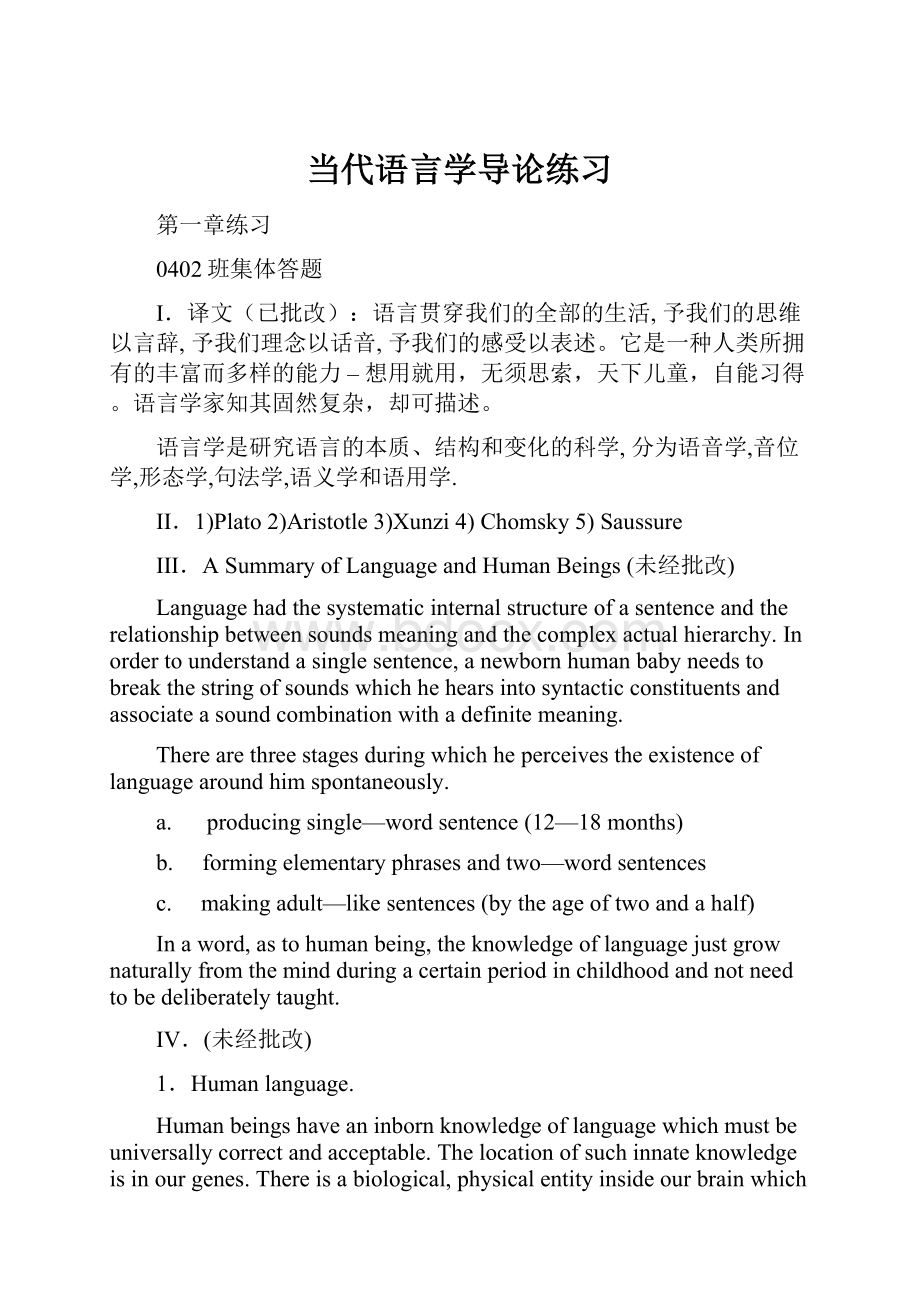当代语言学导论练习.docx
《当代语言学导论练习.docx》由会员分享,可在线阅读,更多相关《当代语言学导论练习.docx(15页珍藏版)》请在冰豆网上搜索。

当代语言学导论练习
第一章练习
0402班集体答题
I.译文(已批改):
语言贯穿我们的全部的生活,予我们的思维以言辞,予我们理念以话音,予我们的感受以表述。
它是一种人类所拥有的丰富而多样的能力–想用就用,无须思索,天下儿童,自能习得。
语言学家知其固然复杂,却可描述。
语言学是研究语言的本质、结构和变化的科学,分为语音学,音位学,形态学,句法学,语义学和语用学.
II.1)Plato2)Aristotle3)Xunzi4)Chomsky5)Saussure
III.ASummaryofLanguageandHumanBeings(未经批改)
Languagehadthesystematicinternalstructureofasentenceandtherelationshipbetweensoundsmeaningandthecomplexactualhierarchy.Inordertounderstandasinglesentence,anewbornhumanbabyneedstobreakthestringofsoundswhichhehearsintosyntacticconstituentsandassociateasoundcombinationwithadefinitemeaning.
Therearethreestagesduringwhichheperceivestheexistenceoflanguagearoundhimspontaneously.
a. producingsingle—wordsentence(12—18months)
b. formingelementaryphrasesandtwo—wordsentences
c. makingadult—likesentences(bytheageoftwoandahalf)
Inaword,astohumanbeing,theknowledgeoflanguagejustgrownaturallyfromthemindduringacertainperiodinchildhoodandnotneedtobedeliberatelytaught.
IV.(未经批改)
1.Humanlanguage.
Humanbeingshaveaninbornknowledgeoflanguagewhichmustbeuniversallycorrectandacceptable.Thelocationofsuchinnateknowledgeisinourgenes.Thereisabiological,physicalentityinsideourbrainwhichdecideswhatwespeak.ThisentityisUG–universalgrammar.AccordingtoUGtheory,everyspeakerisendowedwithasetofprinciples.Animalsdon’thaveanareaintheirbrainthatcontrolslanguage.Nordotheyhavegenesthatcarrytheknowledgeoflanguage.
2Itishardtosay.Nothingisimpossible.Thefirstprerequisitethattheyshouldhaveisabiologicalorgan,likegenesorcertainareasofthebrainthatcandevelopintolanguageskillsorcontrolthelanguageweuse.ThesecondisthattheyshouldhaveUG,whichhelpsthembothtoproduceandunderstandmeaningfulutteranceandsoforth.
3Communicationisoneofthemostbasicfunctionsofhumanlanguage.However,communicationisnottheonlyuse.Weuselanguagesometimestoexpressourselvesandsometimestorecordsomething.Inthiskindofsituation,languageisnotnecessarilyforcommunication.Wenotnecessarilypresentourdiaryorwritingsthatrecordourpersonalemotions.Otherthanthat,wethinkwithlanguage.Thatisnotcommunicationeither.
4Linguisticscanplayaveryimportantroleintheinformationage.Forexample,inthedevelopmentofartificialintelligence,linguisticsisthebasis.TheachievementsinGenerativeGrammargainedbyNoamChomskyhavebeenusedincomputerprogramming,USNavyintelligencetechnologiesandsoforth.Computertranslation,particularly,isbasedonlinguisticknowledge.Therefore,intheinformationage,linguisticscanplayarolethatisasimportantaswhatphysicsandchemistryplayedintheindustrialrevolution.
5CanadaAustria India
V.1)Aone-year-oldchild,toacertainextent,canunderstandmanywordspeopletalkaroundhim.Buthestillcannotmanagetoexpresshimselfwithvocallanguage.Bythistime,exceptforarticulatingsomesimplewords,suchas"dad","mom".Hewouldresorttocryingifhewantssomethingbadly.
Thechild,reachingtheageof14months,istryingto"talk","babble"tobemoreexact.Hewouldkeepproducingmeaninglesssounds;especiallyhelikestoreduplicatesingle-syllablesounds,e.g.Ah-ah,Oh-oh.
Atthe16thmonth,despitetheparentstriedallthepossiblemeanstoteachthechildcorrectpronunciation,thechildwouldrefertohisownsystemwhenheistryingtosaysomething.Forexample,theparentskeepteachingthechildtosay“piqiu”butthechildcanonlycatchthelastsyllable“qiu”,then,moreinterestinghepreferstosay“qiu-qiu”insteadof“qiu”.
Afterabout2months,hecouldsuccessfullyarticulate“pa”and“ma”ifheisrequiredtodoit.,whichgivetheparentslotsofhappiness.Butanotherproblempopsup.Thechildextendsthemeaningof“pa”or“ma”toeverything.E.g.whenthechildwantstogetatoycar,hewouldpointtothecar,saying”pa,pa,pa…”.thisstageistryingtodevelophisownlexicon.Heoftenoverextendsaword’smeaning.
Anotherthingthatworthmentioningisthat,thechildhaslearnedsomebodygesturestoexpresshisownidea.Forexample,whenheishappy,hewillclaphishands,swayingthearmstodemonstrateaflyingbird,stretchingoutonefingertodenote“Iamoneyearold”.
2)Doeslanguageneedanorm?
(未经批改)
Withthehelpofacommonlanguage,peoplecantrytogetridofthedemandingGodbybuildingthetowerofBabel.Nowadays,English,asamostpopularandinternationallanguageseeminglyhasatrendofbecominganotherlanguagenormofmankind.Buttomypointofview,peoplewouldratherpreservetheirownuniquethroughtheuniquelanguage.
Thederivationoflanguageformsacolorfulandshininglanguagenetwhichisarichcultureresourceforallhumanbeings.Withhundredsofthousandsofyears’development,eachindividuallanguageisdeeplyrootedinaspecificculture;somelanguageshavebeenextinctwithoutbeingrecorded,whichcauseagreatlossinourculture.Insteadofchoosingalanguagenorm,peopletrytokeepthepresentsituationoflanguagederivation.
Alsodifferentgroupsofpeopleareblockedoffduetothegeographicalreasons,thosepeopledevelopanewkindoflanguagethatcanfullysatisfiestheyneed.AccordingtoDarwin’stheoryofevolution,thederivationoflanguageistheresultofthesocialdevelopment.
Tosumup,withthedevelopment,therearedifferentlanguageswhicharestronglyimprintedwithdifferentculturecharacteristics.Tofindalanguagenormisaunrealisticandimpracticalway.
翻译(已批阅):
费迪南·德·索绪尔是20世纪之交伟大的瑞士语言学家。
从1881到1891他在巴黎的法国高等学院任教。
随后在日内瓦大学任印欧语言学和梵语教授(1901-1913)。
1907到1913任生成语言学教授。
作为一名教师,他影响巨大,但因为他不断研究以求精益求精,所以他的思想观点在他生前并未发表。
他死后三年,他的两名学生巴利和薛施埃把在他课上摘录的笔记编汇成书出版,题目为《生成语言学课程》。
该书一出版就成为了当时最具影响力的语言学著作。
索绪尔建立了语言结构研究的体系,强调语言符号与其所表示的意义之间的随意关系。
他还主张语言应该被认为是一种社会现象,一种可以从历时和共时两方面来认识的结构体系,并且坚持认为,这两种研究方法显著不同,在方法论上相互排斥。
他还起用了两个现已获得广泛运用的术语——“parole”,即每个人所说的言话,和“langue”,即存在于特定社会特定时期的系统化结构化的语言。
索绪尔提倡赋予“语言”更多的重要性而不是“言语”,并且建议当时的语言学家多搞共识研究,而非历史研究。
他在理论上和方法论上的创新思维得到广泛的认同。
人们称他为现代语言学之父。
Keytothemultiple-choiceandjudgmentexercises
Chapter1
II.1)Plato2)Aristotle3)XunZi4)(Noam)Chomsky
5)(Ferdinandde)Saussure
Chapter2
II.1)Plato2)Herder3)Galileo4)WilliamJohns
5)theLinguisticSocietyofParis
III.1)syntax2)pragmatics3)morphology4)phonetics
5)phonology6)semantics7)semantics
IV.1)psycholinguistics2)historicallinguistics
3)sociolinguistics4)psycholinguistics
5)sociolinguistics6)appliedlinguistics(inthebroadsense)
7)appliedlinguistics8)psycholinguistics
Chapter3
II.Orderofthespeechorgansontheleftcorrespondingtotheirproperdefinitionsontheright:
softpalate;alveolarridge;pharynx;hardpalate;vocalcords;trachea;larynx
III.1)b2)t3)Ѳ4)m5)f6)l7)dʒ8)j9)ŋ10)s
IV.(Thecorrectfeatureisgivenafterthearrow)
1)b)frontcentral
2)a)semi-openopen
3)c)lowhigh
4)c)highmid
5)d)roundedunrounded
V.1)incorrect.insidethechestinsidethehead
2)correct.
3)incorrect.auditoryphoneticsacousticphonetics
4)correct.
5)incorrect.Asyllablecannotcontainmorethanonevowels.Evenifadiphthongorthiphthongiscontained,itisstillasinglevowel,pronouncedwithinonechestpulse.
6)incorrect.Thelocationofthewords“Chinese”and“English”inthestatementsshouldbeexchanged.
7)correct
8)correct
Chapter4
II.1)morphemes2)Bound3)Compounds4)idiomatic
5)agglutinating
III.1)Theoldergentlemanvotedwisely.
aacaaacab
2) Thechildrenskippedropeandplayedgamesjoyfully
aacacaaacacabb
3) 他们赛跑拿了第一。
acaaacba
Chapter5
II.1)head,complement
2)projection,maximal,intermediate,minimal
3)lexical,functional
4)specifier,sisters
5)inflectionalphrase,inflectionalmorphemes,infinitivalparticle
6)complementizerphrase,wh-questions
Chapter6
II.1)propositions;arguments;adjunct2)internal;external:
3)noneorone;none,oneormore4)theta/thematic;argument
III.1)rain(0)2)old(table)
3)sleep(baby)4)like(John,teacher)
IV.1)agent2)experiencer
3)instrument,theme/patient4)agent,theme,benefactive
5)agent,theme,instrument6)theme
Chapter7
II.1)synonyms2)antonyms3)polysemy
4)homophones5)denotative;denotative6)Connotative;Connotative
7)entailment
III.1)paraphrase2)entailment3)contradiction
4)presupposition
V.4)a.Thewindowismaterial.
b.Thewindowisabstract.
c.Thewindowcaneitherbematerialorabstract.
Chapter8
II.1)given;new;Theme,Rheme2)Theme;Rheme3)unmarked;marked
4)topical;interpersonal;textual5)topic;comment
III.(keysareboldfaced)
1)
这棵树,
叶子很大
Theme
Rheme
2)
张三
我已经见过了
Theme
Rheme
3)
老师
站在讲台上
Theme
Rheme
4)
讲台上
站着老师
Theme
Rheme
5)
(you)
Have
Somebreadandbutter
Theme
Rheme
given
new
6)
Please
don’t
touchthecucumbersandwiches
interpersonalTheme
topicalTheme
Rheme
7)
Now
atfirstsight
thismightseemtobecontradictory
textualTheme
topicalTheme
Rheme
8)
Surprisingly
however
thistendencyhasdeclinedinthemid-1970s
InterpersonalTheme
textualTheme
Rheme
IV.主位分析:
1) 哎呀(textualTheme),孙悟空(interpersonalTheme),月光宝石(topicalTheme)怎么能乱扔呢(Rheme)?
2) 好大一会儿(Theme),这伙人谁也没说话(Rheme)。
3)And(textualTheme)nodoubt(interpersonalTheme)he(topicalTheme)’lldenyeverything(Rheme).
4)Well(textualTheme),perhaps(interpe